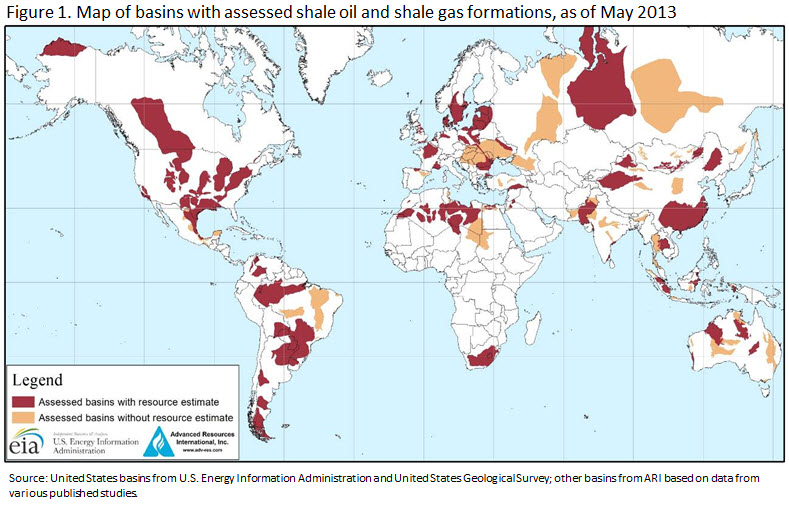EIA Says Worldwide Shale Oil And Gas Potential Is Huge
A surge in oil and gas production from shale rock has transformed energy in the United States, helping reverse declines in oil production and prompting a massive shift from coal to natural gas electricity production that has led to a significant drop in carbon dioxide emissions (since burning coal releases more carbon dioxide than burning natural gas). A new report from the U.S. Energy Information Administration lends support to the idea that a similar transformation could take place outside the United States.

The map above gives a sense of just how widespread oil and gas resources are. The EIA report concludes that Russia has even more technically recoverable shale oil than the United States. Three countries have more shale gas—China, Argentina, and Algeria. Geologists have long known that some shale deposits contain large amounts of oil and gas, but it’s only recently that hydraulic fracturing and horizontal drilling technology have made it feasible to extract.
While other countries may have more of these resources than the United States, the impact in some of them may not be as great, or happen as quickly. It could take many years to develop resources in other countries because the geology is somewhat different—the techniques that work in the United States might not quite work elsewhere. What’s more, many countries don’t have the needed technological expertise. Some countries make it difficult for companies to set up and find ways to exploit the resources (see “China Has Plenty of Shale Gas, But It Will Be Hard to Mine”).
What’s more, the United States had a lot of spare natural gas generating capacity, which made it easy to switch from coal to natural gas. In a place like China, where energy demand is quickly growing, there’s little spare capacity. Natural gas production might only serve to slightly slow the growth of electricity from coal plants, not reverse it.
So far, the impact of increased shale gas production has been limited outside the United States. Because natural gas is relatively expensive to export and requires the construction of specialized infrastructure, prices for natural gas have fallen sharply inside the United States, but not outside the country.
But it has had one impact: increased natural gas production in the U.S. has led to increases in coal consumption elsewhere. Unlike natural gas, coal is relatively easy to export. When demand for it dropped in the U.S., it was shipped abroad, lowering coal prices and contributing to an increase in coal use—and carbon dioxide emissions.
Keep Reading
Most Popular
Large language models can do jaw-dropping things. But nobody knows exactly why.
And that's a problem. Figuring it out is one of the biggest scientific puzzles of our time and a crucial step towards controlling more powerful future models.
The problem with plug-in hybrids? Their drivers.
Plug-in hybrids are often sold as a transition to EVs, but new data from Europe shows we’re still underestimating the emissions they produce.
Google DeepMind’s new generative model makes Super Mario–like games from scratch
Genie learns how to control games by watching hours and hours of video. It could help train next-gen robots too.
How scientists traced a mysterious covid case back to six toilets
When wastewater surveillance turns into a hunt for a single infected individual, the ethics get tricky.
Stay connected
Get the latest updates from
MIT Technology Review
Discover special offers, top stories, upcoming events, and more.